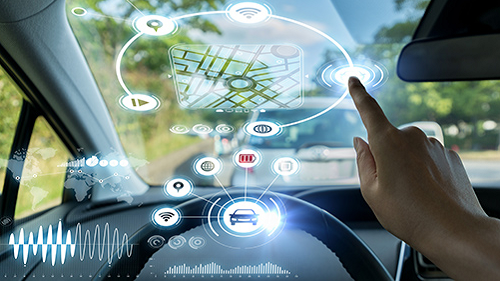Opinion piece by Russ Ruben, Global Automotive Segment Marketing Director, Western Digital
We tend to understand 5G’s next generation connectivity as it relates to our phones and tablets and other personal digital devices.
However, 5G also introduces possibilities for new ways of managing applications related in health monitoring, and manufacturing and industry. The dramatic increase in speed and low latency, powered by 5G, will offer a multitude of benefits and advancements across the automotive field too.
Connected cars and those that have advanced driver-assistance systems are beginning to look more like small data canters. When it comes to sensors and cameras and the storage that saves the data, cars will have systems that move from the current figuration of a distributed architecture and instead constitute various zones connecting to one central ‘brain’ or data hub. The 5G network will enable the transfer of data at a quicker rate, empowering data hubs to be continuously pushing, and receiving, different kinds of data and enhancing vehicle reaction times, keeping drivers safer.
Survey the road
Maps that are constantly being updated with live traffic conditions. As 5G progresses, it will enable maps to capture and deliver much more information in real-time. Vehicles’ sensors and cameras, powered by 5G’s high speed connectivity, will constantly survey the road and their surroundings.
These devices will act as essential eyes and ears for the car, noticing changes in the environment including road conditions, construction, a change in the number of lanes or potential hazards. This data will then be sent to the cloud, where the central database will be updated and information will be pushed out to other vehicles, and potentially others in the road network, like pedestrians, bikers, and the mini base stations at the roadside that take and relay information to drivers, in almost real-time.
V2X communications
A you can imagine, sending data from cars to the cloud, and then back to other vehicles is not quite as fast as enabling cars to directly communicate with each other. This requires sufficient 5G infrastructure. Vehicle-to-everything (V2X) communication is the technology that allows cars to communicate with the different parts of the traffic system that may affect the vehicle, and vice versa.
Until 5G infrastructures have sufficient coverage, and are tested to meet automotive standards, V2X can only be rolled out with direct communication between vehicles or to roadside units at low latency (<100ms) with a maximum 300m range. With 5G, however, cellular V2X (C-V2X) can be rolled out, in which cars can use a direct interface (where a device can communicate with another device over a direct channel) as well as the network Uu interface, which uses cell towers for radio access network.
This will enable cars to communicate up to 600m using the direct interface, and up to 2km with Uu, all with an even lower latency. This larger distance means that vehicles will be able to register and communicate far more moving parts and will have more time to react to road conditions ahead such as accidents, lane closures, icy or wet roads, and debris.
Furthermore, the direct interface allows the vehicle to not only communicate with other cars and roadside units but it will also have the potential to communicate with pedestrians and cyclists via their cell phones and potentially other devices. This is crucial to enhancing safety as it could prevent accidents from blind corners or people entering the street between cars. Both the vehicle and pedestrian/cyclist would be notified of any upcoming potential collisions and could take appropriate action.
OTA as standard
Over-the-air (OTA) software updates are already around today for some vehicles. However, with the acceleration of 5G, this feature will become standard. As we look at the cars of the future, the number and type of applications, sensors and cameras will continue to increase and they will all depend on interdependent services connected to the central hub. All these applications will need to regularly be updated.
The algorithms behind autonomous and smart vehicles will continue to learn and mature as they capture data and push it out to cloud data centers for analysis. As these software elements get smarter, they will then be updated and dispatched over 5G to the vehicles via the OTA module. 5G will mean these updates can be installed more quickly, ensuring that vehicles are constantly operating with the most up-to-date safety features.
These updates will become as common, and likely as frequent, as we have been accustomed to with our smartphone updates.
Data Storage
How does data storage play a role in all of this? Firstly, maps, V2X security keys, application software, data logging, OTA buffering and the millions of lines of software code that already exist in vehicles are, and will continue to be, stored in the vehicle on highly reliable NAND flash-based products. As vehicles move towards the model made up of multiple zones with a central brain, this hub will act as the central storage for the architecture from which each zone will access data. This central hub therefore requires high capacity and highly robust storage architecture; for example, SSD solutions.
Not only is high-capacity storage required to contain the data for each zone, it’s also able to reconstruct accident scenarios. Images or video recordings from an accident are crucial to preserve in order to investigate incidents and inform prevention of those in the future.
As cars become more data-rich, data needs to be able to always move optimally and reliably between the different electronic auto systems. Advancements to NAND-based storage will help alleviate performance bottlenecks which could result from large amounts of data, increase capacity, and offer more reliability.
The promise of 5G is that it will enable massive files of automotive data to move quickly across reliable, robust, and high-capacity storage architectures. Storage is required to capture and retain data and will help manage the shift from today’s driver-assisted vehicles to fully autonomous, connected cars.
by TU-Editor
Source: https://www.tu-auto.com




